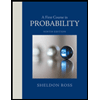
A First Course in Probability (10th Edition)
10th Edition
ISBN: 9780134753119
Author: Sheldon Ross
Publisher: PEARSON
expand_more
expand_more
format_list_bulleted
Question

Transcribed Image Text:Let F(x) be the cumulative distribution function (cdf) of a random variable X. Which of the following is/are true?
F(x) is a non-increasing function.
X is a discrete random variable. If a, b, and X are integers, and a < b, then F(a – 1) + Pr(a < X < b) = F(b).
If a < b, F(a) > F(b).
Y is a continuous random variable. If a < b, then F(a) + Pr(a < Y < b) = F(b).
O O O O
Expert Solution
This question has been solved!
Explore an expertly crafted, step-by-step solution for a thorough understanding of key concepts.
This is a popular solution
Trending nowThis is a popular solution!
Step by stepSolved in 2 steps

Knowledge Booster
Learn more about
Need a deep-dive on the concept behind this application? Look no further. Learn more about this topic, probability and related others by exploring similar questions and additional content below.Similar questions
- If the probability den sity function of a continu ous random variable X is [a+ ba² 0arrow_forwardLet Y be a discrete random variable with generating function 4 Gy (s) 6 - s What is E(Y) (in decimal)? Answer:arrow_forwardLet X be a random variable. Which of the following statement is INCORRECT? If V (X) = 0, then there exists an x, such that Pr(X = x) = 1. There are cases that V(X) does not exist. By the definition of the random variable, the range of X is a subset of R; therefore, there must exist at least one x such that Pr(X = x) > 0. If Pr(X = 1) (E(X))².arrow_forward
- Consider a random variable X taking the values k1, k2, , km E R .. with probability ; Pn E [0, 1] 1. Write down the formula for the P1, P2, .. respectively, where p1 + P2 + expected value of f(X) for a given function f(-). + Pn ...arrow_forwardB5. Let X₁, X₂, ..., Xn be IID random variable with common expectation µ and common variance o², and let X = (X₁ + + X₂)/n be the mean of these random variables. We will be considering the random variable S² given by (a) By writing or otherwise, show that S² (b) Hence or otherwise, show that n S² = (x₁ - x)². = Ĺ(X₂ i=1 X₁ X = (X₁-μ) - (x-μ) = Σ(X; -μ)² - n(X - μ)². i=1 ES² = (n-1)0². You may use facts about X from the notes provided you state them clearly. (You may find it helpful to recognise some expectations as definitional formulas for variances, where appropriate.) (c) At the beginning of this module, we defined the sample variance of the values x₁, x2,...,xn to be S = 1 n-1 n i=1 ((x₁ - x)². Explain one reason why we might consider it appropriate to use 1/(n-1) as the factor at the beginning of this expression, rather than simply 1/n. B6. (New) Roughly how many times should I toss a coin for there to be a 95% chance that between 49% and 510/ of my nain toon land Honda?arrow_forward3. Determine the value c so that each of the following functions can serve as probability distributions of the discrete random variable X: a. f(x) = c(x² +4) for x = 0,1, 2, 3; 3 b. f(x)%3Dс for x= 0,1, 2 3-xarrow_forward
- The possible values of a discrete random variable X are 0, 1, 3, and 6 with respective probabilities 0.2, 0.3, 0.1, 0.4. Find E[X] and Var(X).arrow_forwardAn ordinary (fair) coin is tossed 3 times. Outcomes are thus triples of "heads" (h) and "tails" (t) which we write hth, ttt, etc. For each outcome, let N be the random variable counting the number of tails in each outcome. For example, if the outcome is hth, then N (hth) = 1. Suppose that the random variable X is defined in terms of N as follows: X=2N² − 6N-1. The values of X are given in the table below. Outcome thh tth hhh hth ttt htt hht tht Value of X-5 -5 -1 -5 -1 -5 -5 -5 Calculate the probabilities P(X=x) of the probability distribution of X. First, fill in the first row with the values of X. Then fill in the appropriate probabilities in the second row. Value X of X P(X=x) 0 0 00 Xarrow_forward
arrow_back_ios
arrow_forward_ios
Recommended textbooks for you
 A First Course in Probability (10th Edition)ProbabilityISBN:9780134753119Author:Sheldon RossPublisher:PEARSON
A First Course in Probability (10th Edition)ProbabilityISBN:9780134753119Author:Sheldon RossPublisher:PEARSON

A First Course in Probability (10th Edition)
Probability
ISBN:9780134753119
Author:Sheldon Ross
Publisher:PEARSON
